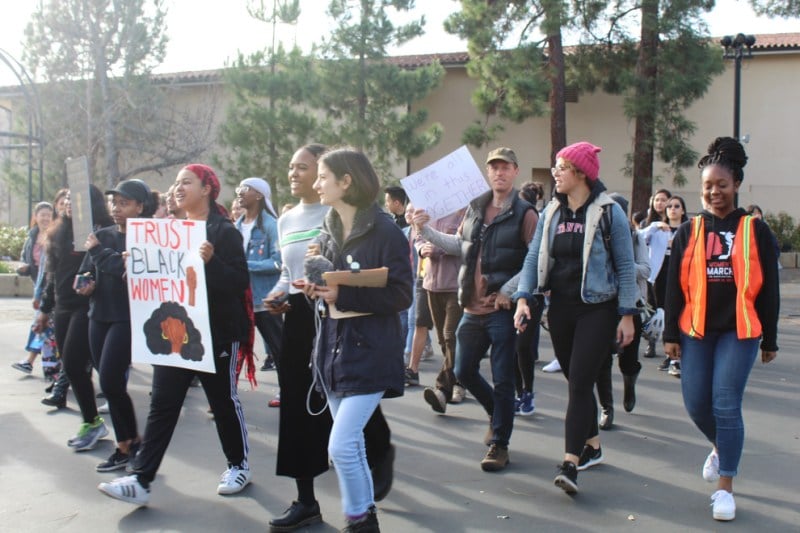Hundreds of Stanford students took their own approach to the third annual Women’s March effort on Saturday, as the Stanford Womxn’s March was held as part of a national push toward gender equality. Whereas the previous Stanford march was affiliated with the National Women’s March, organizers Chloe Stoddard ’21 and Nivedha Soundappan ’21 rechristened the event as the Stanford Womxn’s March this year in an effort to extend the movement to non-female identifying individuals.
“I didn’t know what [womxn] meant until I came to college,” Stoddard said. “It was an opportunity to use the word womxn to acknowledge the exclusivity of feminism’s past and opening the door for individuals who are trans or non-binary to be included in this movement as well.”
Although the national Women’s March began in Jan. 2017 as a rebuke to the inauguration of President Donald Trump, the movement has continued across the United States. Saturday’s march at Stanford was the second such event organized by Stoddard and Soundappan, who held the University’s first Women’s March last January. The organizers decided not to be formally affiliated with the National Women’s March this year in an effort toward inclusivity and in light of the controversies surrounding the organization, including allegations of anti-Semitism amid the organizers’ support for Nation of Islam leader Louis Farrakhan.
The march began at 10 a.m. at White Memorial Plaza. Participants traveled around Main Quad along a route lined with Stanford security officers before ending up on Meyer Green, where six people spoke at an hour-long rally.
Stoddard noted some of the changes that occurred between this year’s march and last year’s.
“We decided to do it last year because we really wanted to have an empowering space and a place to organize for women,” she said. “This year, it’s really about making the space and amplifying the voices of both women and non-binary individuals and advocating for trans women — being clear and intentional about the type of feminism that we’re practicing and acknowledging the history of the exclusive nature of feminism.”
“A lot of our prioritizing in this year’s march was amplifying the voices of marginalized communities, especially those that exist at Stanford,” she added.
During Fall Quarter, Stoddard and Soundappan formed an organizing team of seven to eight students, which began planning the march in late October — another shift from last year’s march, which was planned 10 days before the actual march.
With more time to plan, the organizers secured co-sponsors for the march, including organizations such as the Black Student Union, Pilipino-American Student Union, Hermanas y Stanford, Black Feminist Collective, Asian-American Student Association and the Stanford American Indian Organization. The organizing team also selected six students to speak at the rally at Meyer Green on various topics ranging from gender identity to sexual assault and assault on indigenous women.
According to Stoddard, the University “had a very positive response to us organizing this march.”
For many marchers, marching on campus was different but still powerful in comparison to marching at Women’s Marches in cities. Lindsay Filgas ’22, who marched in Los Angeles last year, noted that “in the city, it was a lot bigger and higher publicity and there were celebrity speakers.”
“Here, it felt a lot more personal because my friends and peers are speaking, and a lot of the speeches dealt with Stanford specifically, which made the issues this march was dealing with a lot more real,” she said.
Stoddard’s motivations for organizing the march were both political and personal.
“I grew up in Wisconsin, in a family of very strong women,” she said. “I was raised by a single mom, and I march especially for all the women who have been with me and made me possible. Feminism should never die on a college campus, and there’s been lots of great advancements,” but sexual assaults on campuses remain a serious issue. ….Nothing would have happened had activists not spoken out.”
“This isn’t the end, it’s just the beginning of creating conversations to address the issues on our campus that haven’t gained traction yet,” said Brooke Beyer ’22, a member of the organizing team who made an effort to reach out to other colleges to try to galvanize additional marches outside of Stanford. “I’ve never marched before because I grew up in a country where that wasn’t allowed, so it was amazing to speak out and address campus issues and start dialogues.”
Mia Bahr ’22, one of the six speakers who spoke on educational inequity and breaking the cycle of oppression through the public education system, shared similar sentiments about the ongoing conversation that for her, the march facilitates.
“There are a lot of problems with the Women’s March, like how it propagates white feminism — what many feminists and feminists call problematic feminism because it focuses on white narratives,” Bahr said. “I do think, however, that it’s one of the biggest steps forward we’ve seen in terms of third wave feminism that we’ve seen so far. I think it has brought forward the issues surrounding gender, sexuality and race to the forefront more so than any other movement so far in the 21st century.
Bahr expressed her belief that more people are becoming aware that oppression is still around.
“In my opinion, as a queer woman of color, we’re living in a world that has finally woken up to the fact that we’re not living in a post racial, post gender, post sexuality age. Oppression still exists, and just because we’ve had a black president and some women elected into Congress doesn’t mean that the struggle is over,” Bahr said.
Contact Sean Lee at seanklee ‘at’ stanford.edu.
